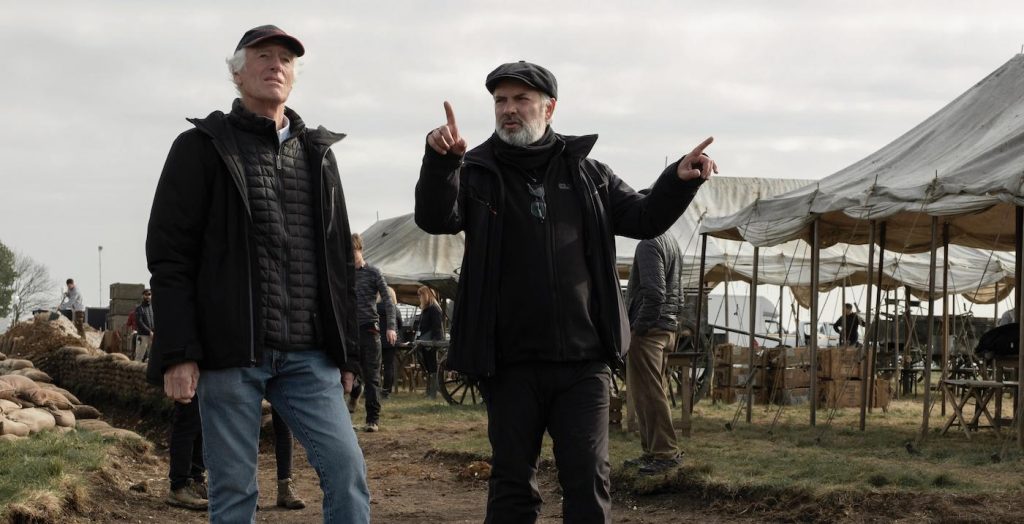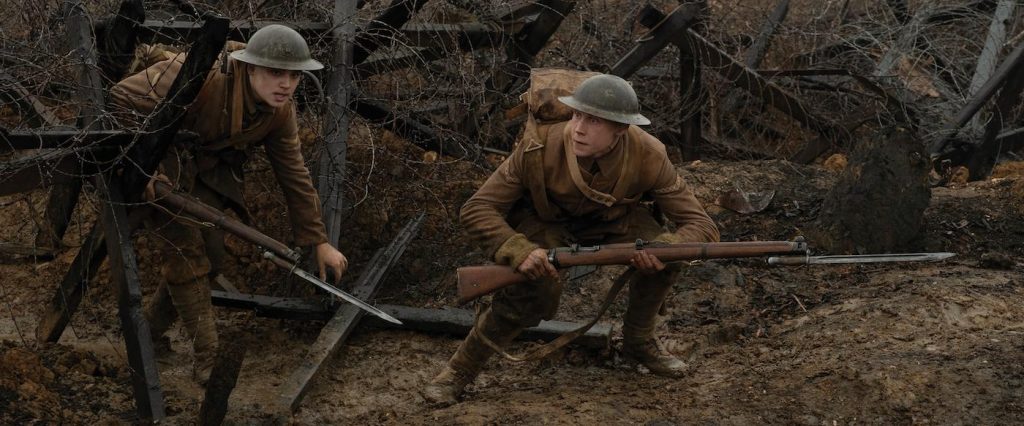How Editor Lee Smith & Sound Editor Oliver Tarney Crafted the Immersive Story of 1917
If you caught last night’s Golden Globes, you saw Sam Mendes‘ World War I epic 1917 take home both Best Film (Drama) and Best Director for Mendes himself. 1917 bested some very steep competition, including Martin Scorsese’s mob epic The Irishman, Todd Phillips Joker, and Noah Baumbach’s Marriage Story. Mendes’ film is practically flawless.
Now imagine you’re a picture editing working on a project where the story is utterly personal to the director, and after having received footage, you have to tell the director it’s not working. That was the predicament editor Lee Smith (Dunkirk, Interstellar) found himself in while on Sam Mendes’s 1917, a film that follows two British soldiers – Lance Corporal Blake (Dean-Charles Chapman) and Lance Corporal Schofield (George MacKay)– at the height of World War I who are tasked to deliver a message to save hundreds of fellow men.
Mendes, who co-wrote the screenplay with Krysty Wilson-Cairns, conceptualized the story as one continuous shot—a language that visually connects the characters to the action and immerses the audience in the trenches of war. In planning the feat, key crew members including production designer Dennis Gassner, cinematographer Roger Deakins, production sound mixer Stuart Wilson and others, rehearsed each second of the journey over multiple months prior to filming. During prep, Smith collaborated with the team to find seamless ways to naturally hide the cuts in each scene.
When the footage started coming in it was Smith who kept tabs on the director’s vision. “It was exciting and stressful all at once. I had to speak up immediately if there was a problem,” admits Smith. “We had things in our armory we could use for fixes but we didn’t want to be patching something that was half working. We wanted it to be right to begin with so Sam would reshoot anything that wasn’t up to the quality of the rest of the film.”

Since Mendes was shooting in a linear fashion, each shooting day informed the next. Rhythm and pace were among the critical topics of conversation between the director and editor. Same with camera composition. “As we were shooting, Sam wanted to make sure the camera was always pointing in the right direction. If there was ever a shot where we felt like we wanted to turn around to see a different perspective or felt the need to cut, it needed to be brought up,” says Smith.
Not only did Smith need to key on the precision of each take but he built the soundscape and added temp music to give Mendes a cut of the film in real-time. “It was important to make it look, sound and feel like a movie right away. To know it will all work as there was no going back on this film,” Smith says.
For supervising sound editor Oliver Tarney (Captain Phillips, The Martian) and the entire post sound team perspective was key in creating its aural flavor. “It was probably the most important note from Sam—that we should help the audience experience what Schofield and Blake experienced,” says Tarney.
A scene that highlights the unique sound language is when Blake and Schofield watch several airplanes fight each other while looking on from a farmhouse. “We don’t hear it as you normally would in a film. It’s pushed back and diffused at first,” says Tarney. “We wanted the audience to focus on the soldiers watching the dogfight rather than the dogfight itself. It’s only as the plane approaches them, and as the sense of a threat to them increases, that we hear more detail. It’s about to affect their world, and as it approaches, we ramp up the intensity and scale of the event.”
Sound and music also aided in controlling the pace and rhythm. “It became evident early on that if we made everything too focused there was a danger of it being too relentless for an audience. We had to build the tension leading up to each big event then strip everything right back down again before starting to build up again,” notes Tarney.
A scene when the sound did pull back happens directly after an intense sequence with the two soldiers inside the German trenches. Sound simplified its design, dialing in a calmer ambiance where even the footsteps were less prominent. “It was a moment we needed to focus on their relationship and our task was to gently augment that,” says Tarney. “This gave time for the audience to recover and get to know the characters while offering us a softer soundscape to build back up from.

Both picture and sound worked together to find ways to link Schofield and Blake even when there was no dialog—to continually connect the characters to the story. “This film proved to be everything we thought it would be but in a wonderful way. Being challenged and to get there with this level of detail is incredible,” says Smith. “It was a marathon but we made it.”
And now the rewards are starting to pile up, with more surely to come when the Oscars arrive.
Featured image: George MacKay as Schofield in “1917,” co-written and directed by Sam Mendes. Photo Credit: François Duhamel / Universal Pictures



